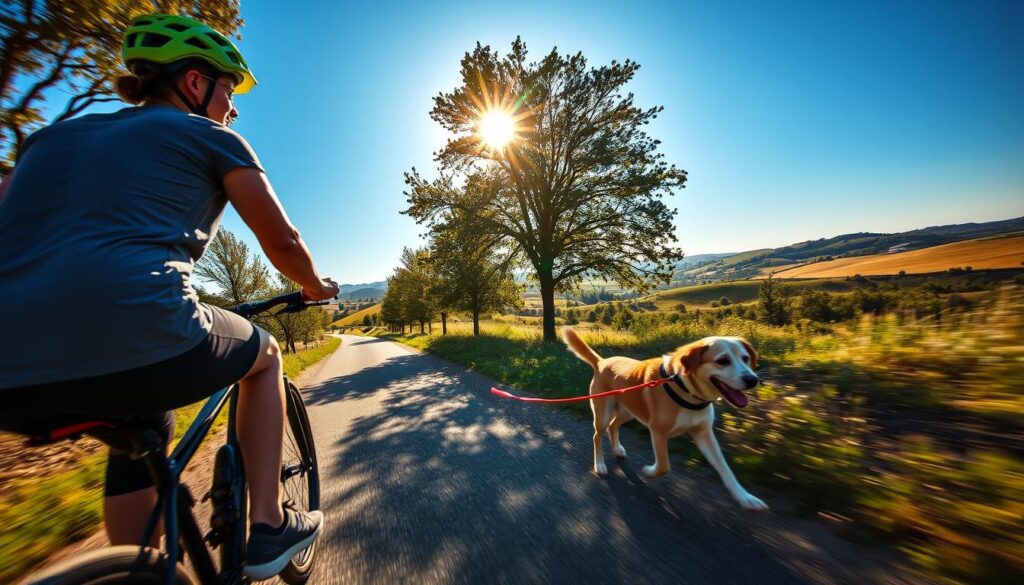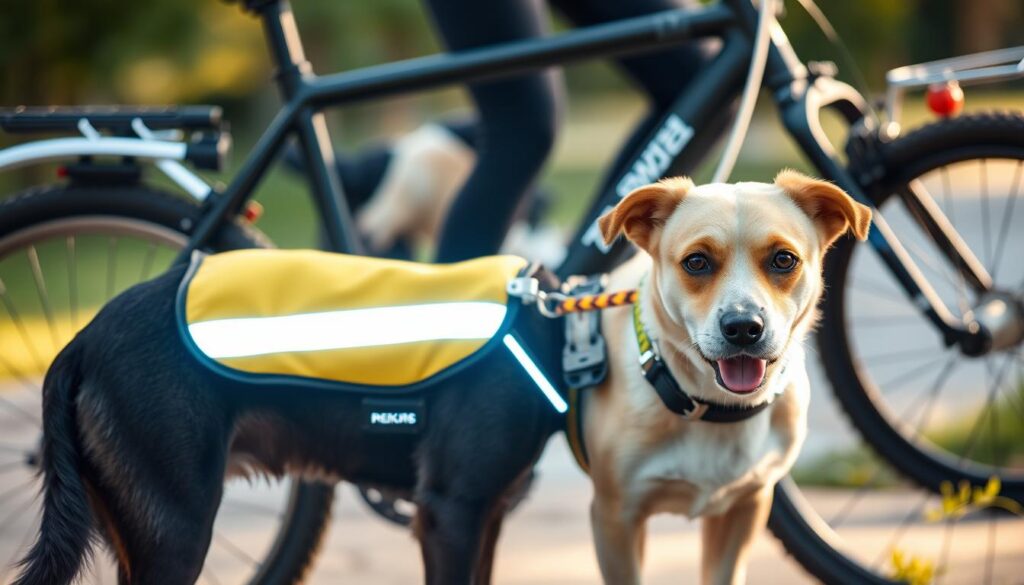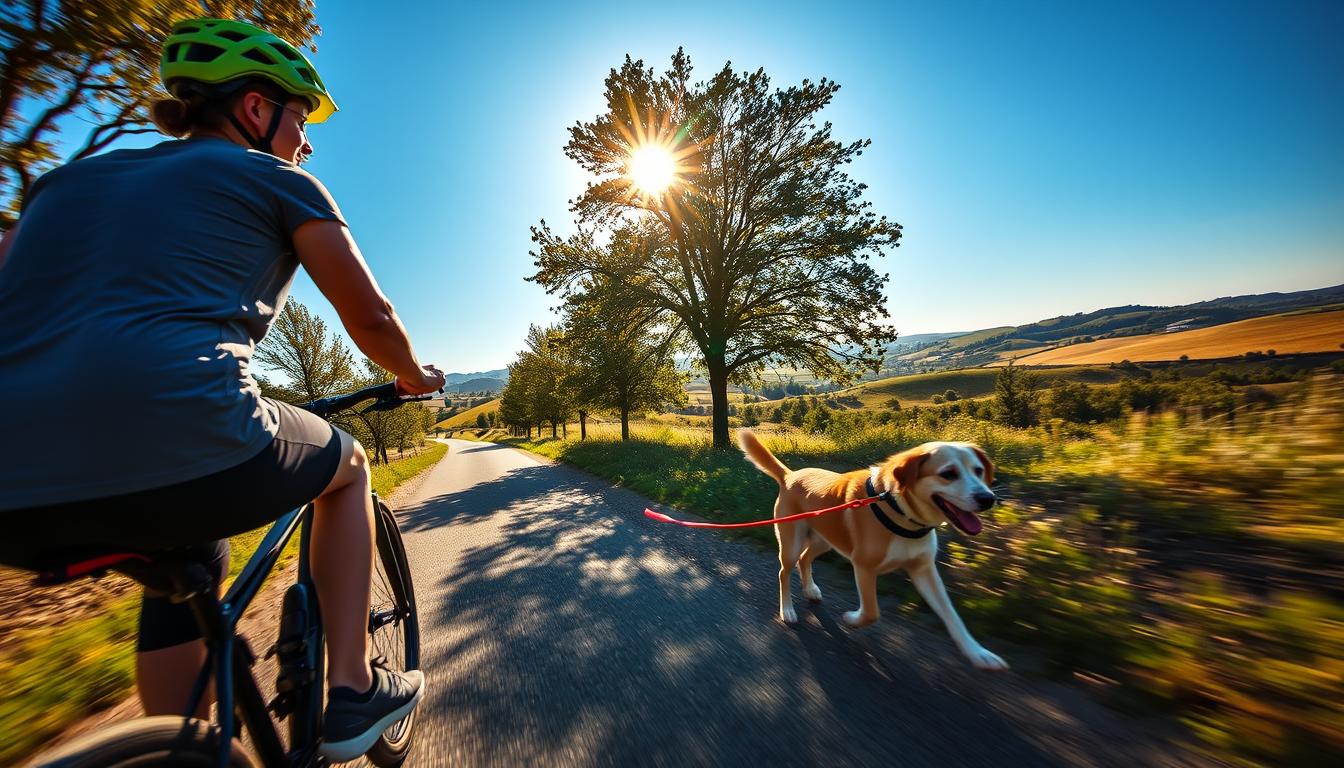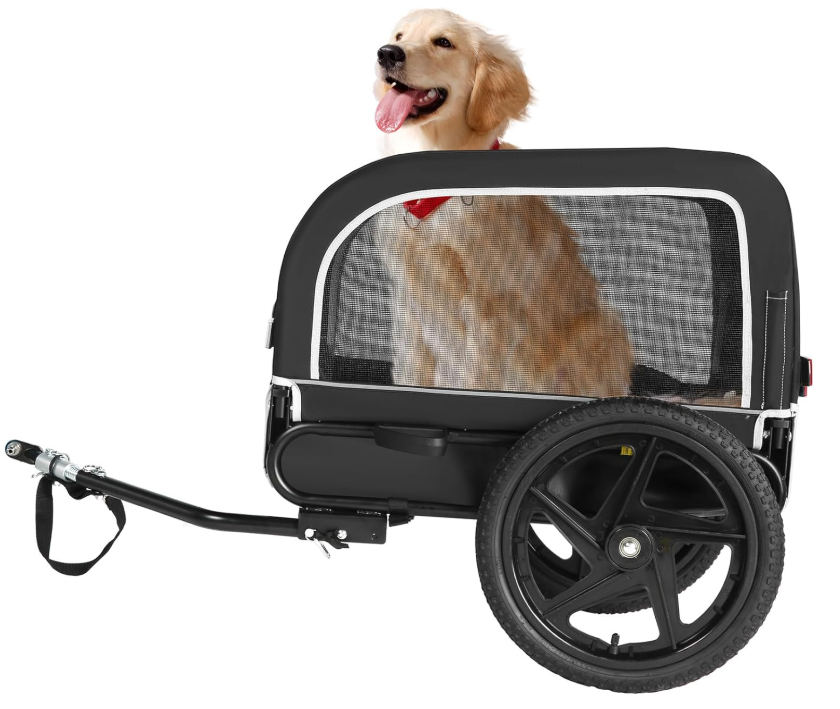
Welcome to the ultimate guide for cycling with your canine companion! Biking with your dog can turn ordinary exercise into an exciting shared adventure. We’ll show you how to make bike and dog leash experiences safe and fun. This will strengthen your bond and keep you both active.
Exercise companions like dogs bring incredible energy and motivation to cycling. Whether you’re a seasoned cyclist or just starting, using a bike with a specialised dog leash is an excellent workout for you and your furry friend.
Safety is our top priority when exploring this exciting fitness method. We’ll guide you through essential techniques, equipment recommendations, and training strategies. This will ensure a smooth and enjoyable bike riding experience with your dog.
Understanding Bike and Dog Leash Safety Basics
Cycling with your dog is a great way to bond. But safety is always the top priority. We’re here to help you have safe and fun adventures with your furry friend.

Choosing the right safety gear is key for bike rides with your dog. The right pet supplies can keep you and your dog safe.
Essential Safety Equipment
Every bike ride with your dog needs special safety gear. Here’s what you’ll need:
- Sturdy bike-specific dog leash
- Reflective safety harnesses
- Padded dog harness with quick-release mechanism
- Protective dog booties for rough terrain
- Hydration pack for both human and canine
Understanding Your Dog’s Fitness Level
Not all dogs are ready for bike rides. Check your dog’s fitness level by looking at:
- Age and overall health
- Breed characteristics
- Current exercise routine
- Veterinarian consultation
“A well-prepared dog is a safe dog!” – Canine Fitness Experts
Basic Commands Your Dog Should Know
Make sure your dog knows these crucial commands before you ride:
- Stop
- Stay
- Heel
- Come
Knowing these commands makes bike rides safe and fun for you and your dog!
Choosing the Right Dog Bike Leash System
Finding the perfect dog bike leashes is essential. Hands-free dog walking systems have changed how we exercise with our pets. Not all leashes are the same, so picking the right one is key for your cycling fun.
- Your dog’s size and strength
- The terrain you’ll ride on
- Your cycling skill level
- The leash’s safety features
Think about bike leash attachments that offer control and safety. The best system should let you move freely while keeping your dog safe.
| Leash Type | Best For | Control Level |
|---|---|---|
| Fixed-Length Bike Leash | Calm, trained dogs | Moderate |
| Retractable Bike Leash | Active, exploratory dogs | Variable |
| Hands-Free Attachment | Experienced cyclists | High |
“The right dog bike leash transforms exercise from a challenge to a joy!” – Veterinary Cycling Expert
Safety is always first. Look for leashes with shock-absorbing features, quick-release mechanisms, and strong materials. They should handle different weather and terrains well.
Proper Bike Equipment for Dog Walking
Preparing your bike for dog walks requires careful thought and the right gear. The right equipment can turn a simple bike ride into a fun and safe outing for you and your dog.
Dog-friendly bike accessories are key for a safe and comfy ride. We’ll look at the critical changes and gear to keep you and your dog safe on the road.
Bicycle Modifications for Safety
Adapting your bike for dog walks is vital. Here are some safety upgrades to consider:
- Install a sturdy bike-mounted dog leash attachment
- Add reinforced bike frame brackets for stability
- Choose a leash system with shock-absorbing capabilities
- Ensure your bike can handle additional side movement
Recommended Bike Accessories
Here are our top picks for dog walking:
- Handlebar-mounted water bottle holder
- Compact treat and waste bag storage compartment
- Padded bike seat for extended rides
- Ergonomic handlebar grips for better control
Visibility and Signalling Equipment
Being seen is key to safety. Get high-visibility gear to protect you and your dog:
- Reflective vest for you and your dog
- LED bike lights and tail markers
- Bright, contrasting bike colours
- Bike bell or electronic signalling device
Remember, the right outdoor equipment can make all the difference in creating a fun and secure biking experience with your dog!

Training Your Dog for Bike Exercise
Getting your furry friend ready for bike adventures takes patience and innovative training. An active lifestyle with your dog can be enriching. We’ll show you how to make bike rides fun for you and your pet.
Begin by slowly introducing your dog to the bike. Use special training tools to help. Start with short, controlled sessions where your dog gets used to the bike.
- Let your dog sniff and investigate the bike
- Reward calm behaviour around the bicycle
- Practice walking beside the bike without moving
- Use positive reinforcement techniques
Train in a structured way. First, teach basic obedience commands. Then, work on verbal cues like “steady,” “slow,” and “stop.” This will help you control your dog during rides.
| Training Stage | Duration | Key Focus |
|---|---|---|
| Initial Introduction | 1-2 weeks | Bike familiarity |
| Command Reinforcement | 2-3 weeks | Obedience skills |
| Short Distance Rides | 1-2 weeks | Bike movement comfort |
Keep an eye on your dog’s energy and health during training. Dogs learn at different speeds. Be patient and adjust your training to meet their needs. The right pet supplies and a consistent routine are key to a successful bike training partnership.
Getting Started with Bike and Dog Leash Combinations
Starting bike rides with your dog needs careful planning and the right gear. Our guide will show you how to cycle with your dog safely and happily!
Setting up your bike and dog leash system is key. The right tools make cycling fun for you and your dog.
Initial Setup Instructions
- Choose a top-notch dog bicycle carrier for secure attachment
- Make sure your bike can handle the extra weight and movement
- Check all connection points for stability and strength
- Adjust the carrier to fit your dog’s size and weight
First Ride Guidelines
Your first bike ride with your dog needs patience and planning. Start with short, easy routes to get used to the new experience.
- Find a quiet, low-traffic area for your first ride
- Start with very short distances (5-10 minutes)
- Keep a slow, steady pace
- Watch your dog’s body language and comfort level
Common Mistakes to Avoid
Many new riders make big mistakes that can be dangerous. Knowing these mistakes helps you and your dog have a great time cycling.
- Never rush the training process.
- Avoid busy or unpredictable routes.
- Don’t ignore your dog’s fitness level.
- Skip rides during extreme weather conditions.
Remember, every dog is unique. What works for one might not work for another!
You and your dog can have amazing bike adventures with the proper prep and attitude. Stay patient, prioritise safety, and enjoy the ride!
Best Practices for Speed and Distance Control
Learning to control speed and distance makes cycling with pets safe and fun. Watching your dog’s energy and how well they can keep up is important. This ensures a good time for both you and your pet.
Begin with short rides and slow speeds. Your dog needs time to get used to the exercise. Look for signs that they’re tired or stressed.
- Start with 10-15 minute rides at a moderate pace
- Gradually increase distance and speed over weeks
- Monitor your dog’s breathing and overall energy
- Take frequent water breaks during exercise
Experts suggest using a special bike leash for pets. These leashes keep the proper distance and prevent sudden moves that could upset you or your dog.
Cycling with pets is about creating a safe, fun experience that strengthens your bond and keeps you both healthy!
It’s essential to know your dog’s fitness level. Young, active dogs can go longer, while older or less active ones need more care. Adjust your rides based on your pet’s needs.
Smooth starts and stops are key to staying in control. Practice these in safe places before tackling more challenging routes with your pets.
Weather Considerations and Seasonal Tips
Biking with your dog needs careful planning for weather changes. Your gear and travel items are key to a safe, fun ride all year. Knowing how seasons affect your bike trips keeps you and your dog safe.
The weather significantly impacts biking with your dog. The proper planning and gear ensure comfort and safety outdoors.
Summer Safety Measures
Summer brings special challenges for dog cyclists. Heat can be hazardous for dogs.
- Check pavement temperature before riding to prevent paw burns
- Plan rides during cooler morning or evening hours
- Carry plenty of water for both you and your dog
- Watch for signs of heat exhaustion
Light, breathable gear is vital in hot weather. Cool vests and portable water bowls are must-haves for summer rides.
Winter Precautions
Cold weather means different safety steps for bike rides with your dog.
- Use reflective gear for increased visibility
- Protect paws with dog booties
- Limit ride duration in frigid temperatures
- Check for salt and ice buildup on paws after rides
In winter, warm, insulating gear is essential. Invest in dog jackets and take shorter, more frequent rides to keep your pet safe and warm.
Troubleshooting Common Challenges
Cycling with your dog can have unexpected challenges. But don’t worry! Our expert tips will help you tackle common issues on bike rides. The right pet accessories and cycling gear are key to a smooth, fun ride.
Here are some essential troubleshooting strategies for safe and enjoyable bike rides:
- Leash Tangling Prevention
- Use specialised pet accessories designed for cycling
- Choose rigid, extendable bike dog leashes with swivel mechanisms
- Practice proper leash handling techniques
- Managing Dog Distractions
- Implement consistent training methods
- Use high-value treats for focus
- Work on impulse control before bike rides
- Handling Sudden Stops
- Train your dog to respond quickly to commands
- Practice emergency stop procedures
- Invest in reliable cycling gear with safety features
“Success with bike dog riding comes from patience, preparation, and understanding your dog’s unique needs!” – Professional Dog Training Expert
Remember, every dog is unique. What works for one might not work for another. Try different techniques and cycling gear to find what works best for you and your dog!
Advanced Techniques for Experienced Riders
Experienced bike riders know how to take their dogs on fun cycling trips. They learn new skills to explore challenging terrains with their dogs.
Ready to take your bike and dog adventures to the next level? Learning to navigate complex routes is key. Dog bike baskets and trailers can make a big difference.
Mastering Complex Trail Navigation
Advanced trail riding needs special skills and gear. Here are some essential tips:
- Use specialised bike trailers for dogs to manage rugged terrain
- Practice smooth gear transitions on uneven surfaces
- Develop precise communication with your dog through hand signals
- Invest in shock-absorbing bike accessories for comfortable rides
Urban Cycling Guidelines
City streets need extra care and special techniques. Dog bike baskets are great for small dogs in the city. Here are some urban cycling tips:
- Stick to designated bike lanes whenever possible
- Maintain consistent, predictable riding patterns
- Use reflective gear for increased visibility
- Plan routes with minimal traffic and smooth surfaces
Safety always comes first when exploring new cycling adventures with your furry companion!
With practice and the right gear, bike rides become unforgettable bonding moments. They challenge and thrill both you and your dog.
Maintaining Your Bike and Dog Leash Equipment
Keeping your bike and dog leash in good shape is essential for safe rides. Regular checks prevent sudden failures. This keeps your gear reliable for outdoor fun.
Looking after your bike and leash system is essential. Begin by checking your bike weekly for any damage.
- Check the bike frame for cracks or rust
- Examine the dog leash attachment for fraying
- Lubricate the bike chain and moving parts
- Clean the leash and harness after each ride
Your pet’s leash and harness need extra care. They can get dirty and sweaty from rides. Clean them with mild soap and let them dry thoroughly.
Where you store your gear matters a lot. Please keep it in a cool, dry spot, away from sunlight. This helps your bike and leash last longer.
Pro tip: Replace dog leash and bike attachments every 12-18 months or when significant wear is visible!
Regular maintenance is key to keeping your gear safe and fun. Going on great rides with your furry friend is worth the effort!
Conclusion
Starting bike adventures with your dog is exciting. This guide has given you the basics to make safe, fun rides. These rides will improve your health and your bond with your dog.
Success comes from being patient, training regularly, and focusing on safety. Each ride is a chance to find new places, challenge yourselves, and make memories. Riding bikes with your dog is good for your health and brings happiness to both of you.
As you get better, you’ll see how great bike rides with your dog can be. Begin slowly, watch your dog’s comfort, and celebrate each success. The future is full of fun rides and memorable moments together.
Every dog is different, so your bike rides will be special to you. Be flexible, listen to your dog, and enjoy the fun of an active life together. Your hard work in training and safety will turn simple rides into amazing adventures!
FAQ
Is a bike dog leash safe to use?
A bike dog leash can be safe if you use it right. Make sure you have the proper training and equipment. Choose a hands-free bike leash made for cycling. It should attach well to your bike and let your dog move freely.
What size dog works best for biking?
Dogs between 30 and 80 pounds are usually suitable for biking. Smaller dogs might tire fast, while big dogs can be hard to control. Pick a dog that fits your biking style and talk to your vet first.
How long can I bike with my dog?
Begin with 10-15-minute rides and increase the time. Depending on their health and breed, dogs can bike for 30-60 minutes. Watch for signs like heavy breathing or slowing down.
What equipment do I need for bike dog walking?
You’ll need a bike dog leash, a comfy harness, reflective clothes, water, and a first-aid kit. Also, make sure your bike is ready for a dog. Choose high-quality, pet-safe gear.
Can all dog breeds bike?
Not all dogs are suitable for biking. High-energy breeds like Labradors and Border Collies are best. Some breeds or dogs with health issues might not do well. Always check with your vet.
How do I train my dog to bike with me?
Training takes time and patience. Start by letting your dog get used to the bike. Practice basic commands and use positive rewards. Begin with short, slow rides.
What safety precautions should I take?
Use a good bike dog leash, wear reflective clothes, and keep a steady speed. Avoid very hot or cold weather. Bring water and check your dog’s paws. Always put your dog’s safety first.
What weather conditions are safe for biking with a dog?
The best weather is 50-70°F. Stay away from extreme temperatures. In summer, bike when it’s cooler. In winter, use dog booties and avoid cold surfaces.
How fast can I bike with my dog?
Most dogs like 8-12 miles per hour. Start slow and go faster as your dog gets stronger. Always match your speed to your dog’s ability. Watch for signs of tiredness.
Do I need special bike modifications?
Some bike changes can make biking safer. Add a strong leash attachment, fenders to keep your dog dry, and make sure your bike can handle the extra weight.








Pingback: Obese Dog? Canine Obesity In Dogs and Healthy Weight Loss - The Pet Advisor
Pingback: Dog Apparel Size Chart: Find the Perfect Fit for Your Furry Friend - The Pet Advisor
Pingback: Dog Panting at Night: Causes and What to Do - The Pet Advisor